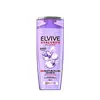What's inside
What's inside
 Key Ingredients
Key Ingredients

No key ingredients
 Benefits
Benefits

 Concerns
Concerns

 Ingredients Side-by-side
Ingredients Side-by-side

Water
Skin ConditioningSodium Laureth Sulfate
CleansingSodium Lauryl Sulfate
CleansingCocamidopropyl Betaine
CleansingSodium Chloride
MaskingGlycol Distearate
EmollientHexylene Glycol
EmulsifyingParfum
MaskingCocamide Mea
EmulsifyingCitric Acid
BufferingSodium Benzoate
MaskingSodium Hydroxide
BufferingDimethicone
EmollientCarbomer
Emulsion StabilisingCoco-Betaine
CleansingSalicylic Acid
MaskingGuar Hydroxypropyltrimonium Chloride
Skin ConditioningAmodimethicone
Trideceth-10
CleansingPEG-100 Stearate
Steareth-6
EmulsifyingSodium Hyaluronate
HumectantPhenoxyethanol
PreservativeLimonene
PerfumingTrideceth-3
EmulsifyingFumaric Acid
BufferingAcetic Acid
BufferingCI 60730
Cosmetic ColorantCI 60725
Cosmetic ColorantWater, Sodium Laureth Sulfate, Sodium Lauryl Sulfate, Cocamidopropyl Betaine, Sodium Chloride, Glycol Distearate, Hexylene Glycol, Parfum, Cocamide Mea, Citric Acid, Sodium Benzoate, Sodium Hydroxide, Dimethicone, Carbomer, Coco-Betaine, Salicylic Acid, Guar Hydroxypropyltrimonium Chloride, Amodimethicone, Trideceth-10, PEG-100 Stearate, Steareth-6, Sodium Hyaluronate, Phenoxyethanol, Limonene, Trideceth-3, Fumaric Acid, Acetic Acid, CI 60730, CI 60725
Water
Skin ConditioningDecyl Glucoside
CleansingSodium Lauroyl Lactylate
EmulsifyingParfum
MaskingGlycol Stearate
EmollientGlycerin
HumectantPanthenol
Skin ConditioningGuar Hydroxypropyltrimonium Chloride
Skin ConditioningButyrospermum Parkii Butter
Skin ConditioningHoney
HumectantTrichilia Emetica Seed Butter
EmollientAdansonia Digitata Seed Oil
EmollientFicus Carica Fruit/Leaf Extract
Skin ConditioningAloe Barbadensis Leaf Juice
Skin ConditioningHydrolyzed Rice Protein
Skin ConditioningCaprylyl Glycol
EmollientCaprylhydroxamic Acid
Stearamide Amp
Citric Acid
BufferingWater, Decyl Glucoside, Sodium Lauroyl Lactylate, Parfum, Glycol Stearate, Glycerin, Panthenol, Guar Hydroxypropyltrimonium Chloride, Butyrospermum Parkii Butter, Honey, Trichilia Emetica Seed Butter, Adansonia Digitata Seed Oil, Ficus Carica Fruit/Leaf Extract, Aloe Barbadensis Leaf Juice, Hydrolyzed Rice Protein, Caprylyl Glycol, Caprylhydroxamic Acid, Stearamide Amp, Citric Acid
 Reviews
Reviews

Ingredients Explained
These ingredients are found in both products.
Ingredients higher up in an ingredient list are typically present in a larger amount.
Citric Acid is an alpha hydroxy acid (AHA) naturally found in citrus fruits like oranges, lemons, and limes.
Like other AHAs, citric acid can exfoliate skin by breaking down the bonds that hold dead skin cells together. This helps reveal smoother and brighter skin underneath.
However, this exfoliating effect only happens at high concentrations (20%) which can be hard to find in cosmetic products.
Due to this, citric acid is usually included in small amounts as a pH adjuster. This helps keep products slightly more acidic and compatible with skin's natural pH.
In skincare formulas, citric acid can:
While it can provide some skin benefits, research shows lactic acid and glycolic acid are generally more effective and less irritating exfoliants.
Most citric acid used in skincare today is made by fermenting sugars (usually from molasses). This synthetic version is identical to the natural citrus form but easier to stabilize and use in formulations.
Read more about some other popular AHA's here:
Learn more about Citric AcidThis ingredient is derived from guar gum.
It is a conditioning ingredient, meaning it helps soften skin and hair.
Parfum is a catch-all term for an ingredient or more that is used to give a scent to products.
Also called "fragrance", this ingredient can be a blend of hundreds of chemicals or plant oils. This means every product with "fragrance" or "parfum" in the ingredients list is a different mixture.
For instance, Habanolide is a proprietary trade name for a specific aroma chemical. When used as a fragrance ingredient in cosmetics, most aroma chemicals fall under the broad labeling category of “FRAGRANCE” or “PARFUM” according to EU and US regulations.
The term 'parfum' or 'fragrance' is not regulated in many countries. In many cases, it is up to the brand to define this term.
For instance, many brands choose to label themselves as "fragrance-free" because they are not using synthetic fragrances. However, their products may still contain ingredients such as essential oils that are considered a fragrance by INCI standards.
One example is Calendula flower extract. Calendula is an essential oil that still imparts a scent or 'fragrance'.
Depending on the blend, the ingredients in the mixture can cause allergies and sensitivities on the skin. Some ingredients that are known EU allergens include linalool and citronellol.
Parfum can also be used to mask or cover an unpleasant scent.
The bottom line is: not all fragrances/parfum/ingredients are created equally. If you are worried about fragrances, we recommend taking a closer look at an ingredient. And of course, we always recommend speaking with a professional.
Learn more about ParfumWater. It's the most common cosmetic ingredient of all. You'll usually see it at the top of ingredient lists, meaning that it makes up the largest part of the product.
So why is it so popular? Water most often acts as a solvent - this means that it helps dissolve other ingredients into the formulation.
You'll also recognize water as that liquid we all need to stay alive. If you see this, drink a glass of water. Stay hydrated!
Learn more about Water